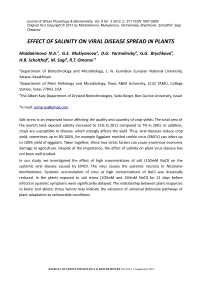Effect of salinity on viral disease spread in plants
Автор: Moldakimova N.A., Mukiyanova G.S., Yarmolinsky D.G., Brychkova G.G., Scholthof H.B., Sagi M., Omarov R.T.
Журнал: Журнал стресс-физиологии и биохимии @jspb
Рубрика: Supplement
Статья в выпуске: 3 т.8, 2012 года.
Бесплатный доступ
Salt stress, systemic viral disease, emcv, nicotiana benthamiana, biotic and abiotic stress factors
Короткий адрес: https://sciup.org/14323634
IDR: 14323634
Текст статьи Effect of salinity on viral disease spread in plants
1Department of Biotechnology and Microbiology, L. N. Gumilyov Eurasian National University, Astana, Kazakhstan
3The Albert Katz Department of Dryland Biotechnologies, Sede-Boqer, Ben-Gurion University, Israel
Salt stress is an important factor affecting the quality and quantity of crop yields. The total area of the world’s land exposed salinity increased to 15% in 2011 compared to 7% in 2001. In addition, crops are susceptible to disease, which strongly affects the yield. Thus, viral diseases reduce crop yield, sometimes up to 80-100%, for example Eggplant mottled crinkle virus (EMCV) can infect up to 100% yield of eggplant. Taken together, these two stress factors can cause enormous economic damage to agriculture. Despite of the importance, the effect of salinity on plant virus disease has not been well studied.
In our study, we investigated the effect of high concentrations of salt (150mM NaCl) on the systemic viral disease caused by EMCV. The virus causes the systemic necrosis in Nicotiana benthamiana . Systemic accumulation of virus at high concentrations of NaCl was drastically reduced. In the plants exposed to salt stress (100mM and 150mM NaCl) for 21 days before infection systemic symptoms were significantly delayed. The relationship between plant responses to biotic and abiotic stress factors may indicate the existence of universal defensive pathways of plant adaptation to unfavorable conditions.
JOURNAL OF STRESS PHYSIOLOGY & BIOCHEMISTRY Vol. 8 No. 3 Supplement 2012


